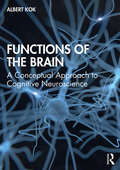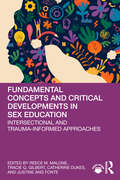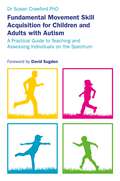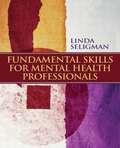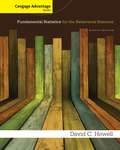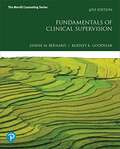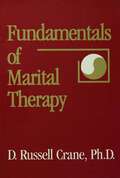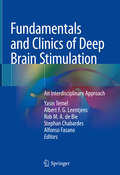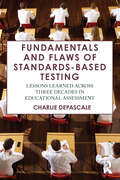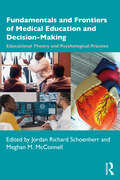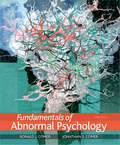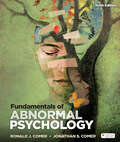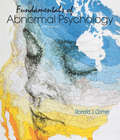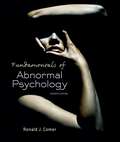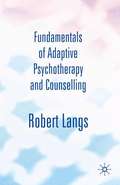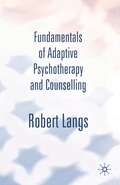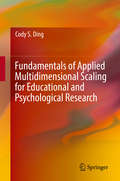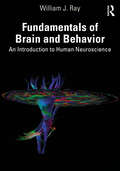- Table View
- List View
Functions of the Brain: A Conceptual Approach to Cognitive Neuroscience
by Albert KokConsidering how computational properties of the brain inform cognitive functions, this book presents a unique conceptual introduction to cognitive neuroscience. This essential guide explores the complex relationship between the mind and the brain, building upon the authors’ extensive research in neural information processing and cognitive neuroscience to provide a comprehensive overview of the field. Rather than providing detailed descriptions of different cognitive processes, Functions of the Brain: A Conceptual Approach to Cognitive Neuroscience focuses on how the brain functions using specific processes. Beginning with a brief history of early cognitive neuroscience research, Kok goes on to discuss how information is represented and processed in the brain before considering the underlying functional organization of larger-scale brain networks involved in human cognition. The second half of the book addresses the architecture of important overlapping areas of cognition, including attention and consciousness, perception and action, and memory and emotion. This book is essential reading for upper-level undergraduates studying Cognitive Neuroscience, particularly those taking a more conceptual approach to the topic.
Fundamental Concepts and Critical Developments in Sex Education: Intersectional and Trauma-Informed Approaches
by Tracie Q. Gilbert Reece M. Malone Catherine Dukes Justine Ang FonteThis comprehensive resource equips emerging and experienced sexuality educators with contemporary frameworks for trauma-informed, equitable, and anti-oppressive education.It provides foundational principles for development and delivery, emphasizing inclusivity, accessibility, and intersectionality. Editors Malone, Gilbert, Dukes, and Fonte curate chapters by leading voices on topics such as historical perspectives, values, emotional intelligence, professional humility, reproductive justice, neurodivergence, sex work, kink, childhood and adolescent sexualities, faith-based education, social media, and entrepreneurship. Authors demonstrate decolonization, trauma-informed care, and equity in practice.With practical applications and reflective questions, this book is a vital guide for creating and teaching impactful, inclusive sex education for diverse audiences.
Fundamental Issues of Artificial Intelligence (Synthese Library #376)
by Vincent C. MüllerThis volume offers a look at the fundamental issues of present and future AI, especially from cognitive science, computer science, neuroscience and philosophy. This work examines the conditions for artificial intelligence, how these relate to the conditions for intelligence in humans and other natural agents, as well as ethical and societal problems that artificial intelligence raises or will raise. The key issues this volume investigates include the relation of AI and cognitive science, ethics of AI and robotics, brain emulation and simulation, hybrid systems and cyborgs, intelligence and intelligence testing, interactive systems, multi-agent systems, and super intelligence. Based on the 2nd conference on “Theory and Philosophy of Artificial Intelligence” held in Oxford, the volume includes prominent researchers within the field from around the world.
Fundamental Movement Skill Acquisition for Children and Adults with Autism: A Practical Guide to Teaching and Assessing Individuals on the Spectrum
by Susan Crawford David SugdenThis innovative manual sets out advice on fundamental movement skill acquisition (FMS) and its benefits for improving physical, verbal and social skills for people with Autistic Spectrum Disorder (ASD). Improving FMS can help prevent long term health issues, and increase opportunities for social engagement and independence. The book explores the basic skills of movement (running, catching, throwing, and balance) and how to observe, teach and assess FMS in children and adults with ASD. There are sections on how to develop and implement a programme for individuals to guide their personal development, and information on planning and tools for assessment are included. A much needed guide on how to combat impairment of FMS, the book also highlights the numerous benefits of such an approach in relation to behaviour, lifestyle, health and education.
Fundamental Skills for Mental Health Professionals
by Linda SeligmanThis book is intended to help students and novice clinicians, as well as more experienced clinicians, in the mental health professions of counseling, psychology, and social work to develop competence in the fundamental skills of their profession. With a solid grounding in such skills as effective use of questions, reflection of feelings, eliciting and modifying dysfunctional thoughts, and behavioral change strategies, clinicians can both acquire a sound understanding of their clients and develop strong helping skills.
Fundamental Statistics for Social Research: Step-by-Step Calculations and Computer Techniques Using SPSS for Windows
by Duncan CramerThis accessible introduction to statistics using the program SPSS for Windows explains when to apply and how to calculate and interpret a wide range of statistical procedures commonly used in the social sciences. Keeping statistical symbols and formulae to a minimum and using simple examples, this book:* assumes no prior knowledge of statistics or computing* includes a concise introduction to the program SPSS for Windows* describes a wider range of tests than other introductory texts* contains a comprehensive range of exercises with answersFundamental Statistics for Social Research covers SPSS Release 6 for Windows 3.1 and Release 7 for Windows 95. It will prove an invaluable introductory statistics text for students, and a useful resource for graduates and professionals engaged in research in the social sciences.
Fundamental Statistics for the Behavioral Sciences 8th Edition
by David C. HowellFUNDAMENTAL STATISTICS FOR THE BEHAVIORAL SCIENCES focuses on providing the context of statistics in behavioral research, while emphasizing the importance of looking at data before jumping into a test. This practical approach provides readers with an understanding of the logic behind the statistics, so they understand why and how certain methods are used--rather than simply carry out techniques by rote. Readers move beyond number crunching to discover the meaning of statistical results and appreciate how the statistical test to be employed relates to the research questions posed by an experiment. An abundance of real data and research studies provide a real-life perspective and help you understand concepts as you learn about the analysis of data.
Fundamental Uncertainty
by Roberto Scazzieri Silva Marzetti Dall’Aste BrandoliniThis volume addresses the subject of uncertainty from the point of view of an extended conception of rationality. In particular, the contributions explore the premises and implications of plausible reasoning when probabilities are non-measurable or unknown, and when the space of possible events is only partially identified.
Fundamentalism or Tradition: Christianity after Secularism (Orthodox Christianity and Contemporary Thought)
by Aristotle Papanikolaou and George E. DemacopoulosTraditional, secular, and fundamentalist—all three categories are contested, yet in their contestation they shape our sensibilities and are mutually implicated, the one with the others. This interplay brings to the foreground more than ever the question of what it means to think and live as Tradition. The Orthodox theologians of the twentieth century, in particular, have emphasized Tradition not as a dead letter but as a living presence of the Holy Spirit. But how can we discern Tradition as living discernment from fundamentalism? What does it mean to live in Tradition when surrounded by something like the “secular”? These essays interrogate these mutual implications, beginning from the understanding that whatever secular or fundamentalist may mean, they are not Tradition, which is historical, particularistic, in motion, ambiguous and pluralistic, but simultaneously not relativistic.Contributors: R. Scott Appleby, Nikolaos Asproulis, Brandon Gallaher, Paul J. Griffiths, Vigen Guroian, Dellas Oliver Herbel, Edith M. Humphrey, Slavica Jakelić, Nadieszda Kizenko, Wendy Mayer, Brenna Moore, Graham Ward, Darlene Fozard Weaver
Fundamentals Of Clinical Supervision (What's New In Counseling Ser.)
by Rodney Goodyear Janine BernardThe standard for clinical supervision Fundamentals of Clinical Supervision, 6th Edition offers a comprehensive, interdisciplinary approach that makes it the most highly cited publication in the field and an authoritative resource for anyone seeking certification as an Approved Clinical Supervisor. Readers gain a thorough view of clinical supervision as they explore central themes from a variety of mental health professions, as well as the important topics of supervision models and modalities, administrative issues, and professional concerns. Retaining its accessible style, the 6th Edition includes additional coverage of multicultural supervision and competence, emerging supervision models, use of technology in supervision, new sections on group work and ethics, increased attention to client outcomes, and a significant focus on supervision beyond training. A new appendix includes supervision examples to help readers connect theory to practice. Its one-of-a-kind supervision toolbox, scholarly approach, and thorough topic coverage sets Fundamentals of Clinical Supervision apart.
Fundamentals Of College Admission Counseling (fifth Edition): A Textbook For Graduate Students And Practicing Counselors
by National Association for College Admission CounselingCompletely updated, the textbook is the definitive classroom resource for graduate education programs in secondary school counseling. It is also a must-read for practicing counselors, particularly those new to the profession. The textbook includes 26 chapters authored by leading practitioners as well as researchers and higher education faculty. The text includes information on counseling foundations and theory, ethics and practice, student pathways and options, serving diverse student populations, and more. This edition also includes the following new Foundations of Standardized Admission Testing Advising Students and Families About Paying for College Counseling First-Generation Students and Families Technology Tools for the Savvy School Counselor Serving Undocumented Students Counseling International Students at US High Schools Advising the Transnational Applicant
Fundamentals Of Marital Therapy
by D. Russell CranePublished in 1996, Fundamentals of Marital Therapy is a valuable contribution to the field of Family Therapy.
Fundamentals Success: A Q & A Review Applying Critical Thinking to Test Taking (3rd Edition)
by Patricia M. Nugent Barbara A. VitaleCompletely revised and updated, the 3rd Edition of this popular resource features more than 1,200 classroom-tested, NCLEX-style questions that reflect the latest advances in medical technology as well as the most recent guidelines and standards of care for nursing practice.
Fundamentals and Clinics of Deep Brain Stimulation: An Interdisciplinary Approach
by Alfonso Fasano Yasin Temel Albert F. G. Leentjens Rob M. A. de Bie Stephan ChabardesThis book provides a state-of-the-art overview of our current understanding of deep brain stimulation (DBS) for the treatment of neurological and psychiatric disorders. With a broad multidisciplinary scope, it presents contributions from leading experts in the field from Europe and America, who share not only their knowledge, but their experience as well. The book focuses both on basic and theoretical aspects of DBS, as well as clinical and practical aspects. It follows an evidence-based approach, and where possible offers clinical recommendations based on published guidelines.It starts with a general section, which discusses basic principles and general considerations. This is followed a sections dedicated to neurological disorders, and psychiatric disorders, in which only accepted indications are discussed. All experimental indications are discussed in the final chapter. The text is supplemented with numerous illustrations.Intended for medical specialists and residents involved in the treatment of patients with DBS, it also appeals to other professionals working with DBS patients, such as psychologists, nurses, physiotherapists, as well as basic and clinical neuroscientists.
Fundamentals and Flaws of Standards-Based Testing: Lessons Learned Across Three Decades in Educational Assessment
by Charlie DePascaleWhen put to the test, will standards-based reporting remain as “fundamentally flawed” as once feared, or can next-generation approaches refine the system for the better? Fundamentals and Flaws of Standards-Based Testing offers an inside perspective on the technical challenges encountered during each phase of the assessment cycle. Careers in state testing are spent balancing technical, logistical, financial, political, psychological, sociocultural, emotional, and measurement considerations while keeping an eye on the educational goals of the state assessment program. This insightful and comprehensive book draws on measurement foundations and real-life experiences in state testing to discuss critical and still unresolved technical and policy challenges that are being inherited by today’s assessment specialists and psychometricians.Going beyond core descriptions of psychometric and assessment development procedures and operational best practices in testing, this book exposes graduate students and scholars of educational measurement and policy as well as testing industry professionals to real-life pressures faced by those charged with designing, implementing, and maintaining a large-scale state assessment program. Standard-setting, test design, score reporting, validation, and more are approached critically and with authentic context.
Fundamentals and Frontiers of Medical Education and Decision-Making: Educational Theory and Psychological Practice
by Jordan Richard Schoenherr Meghan M. McConnellFundamentals and Frontiers of Medical Education and Decision-Making brings together international experts to consider the theoretical, practical, and sociocultural foundations of health professions education. In this volume, the authors review the foundational theories that have informed the early transition to competency-based education. Moving beyond these monolithic models, the authors draw from learning and psychological sciences to provide a means to operationalize competencies. The chapters cover fundamental topics including the transition from novices to experts, the development of psychomotor skills in surgery, the role of emotion and metacognition in decision-making, and how practitioners and laypeople represent and communicate health information. Each section provides chapters that integrate and advance our understanding of health professions education and decision- making. Grounded in psychological science, this book highlights the fundamental issues faced by healthcare professionals, and the frontiers of learning and decision-making. It is important reading for a wide audience of healthcare professionals, healthcare administrators, as well as researchers in judgment and decision-making.
Fundamentals of Abnormal Psychology
by Ronald Comer Jonathan ComerAn award-winning teacher, accomplished researcher, and experienced therapist, Ron Comer knows how to communicate the complexities of abnormal psychology, speak to the concerns of students, and empathically portray the real human impact of psychological disorders. For the 9th edition of this market leading textbook, Ron is joined by Jonathan Comer who brings his expertise in developmental psychopathology research, brain circuitry, cognitive-behavioral research, and technology-driven treatment -- all of which pervade the new edition of this successful abnormal psychology textbook. <p><p> With its signature integrated coverage of theory, diagnosis, and treatment, and inclusive cross-cultural perspective, this new edition of Comer's widely adopted textbook shows students where the study and treatment of psychological disorders stand today. In addition to a thorough updating, the new edition integrates the developmental psychopathology perspective to integrate the explanations and treatments for psychological disorders offered by the various models; updates coverage of biological models to include new research on brain circuits; and combines behavioral and cognitive explanations and treatments for psychological disorders into a coherent and nuanced cognitive-behavioral model. Comer/Comer's Fundamentals of Abnormal Psychology, 9e employs some extraordinary interactive tools to bring students face to face with the realities of psychological dysfunction, organized for easy access and assignability in LaunchPad, Worth Publishers' online course space.
Fundamentals of Abnormal Psychology
by Ronald Comer Jonathan ComerThe new edition of the Comers’ landmark text is the first to take account of the psychological impact of the COVID pandemic.
Fundamentals of Abnormal Psychology
by Ronald J. ComerThe #1 bestselling author of introductory textbooks in abnormal psychology, Ron Comer is remarkably skillful at communicating the scientific foundations, the clinical realities, and the human cost of psychological dysfunction. In this new edition of his brief text, Comer again draws on his experience as an educator, researcher, and practicing therapist to cover the basic concepts of psychopathology in a way that is scientifically sound, widely accessible, and extraordinarily empathetic. The new edition features Comer's signature integration of theory, diagnosis, and treatment, as well as his broadly inclusive cross-cultural perspective. In addition to updated coverage throughout, it offers a number of features created under Comer's supervision that bring fresh, effective new teaching approaches to the text and accompanying media, including infographics (large-scale step by step illustrations of complex concepts), video case studies and activities, and the new online feature, Clinical Choices, which puts students in the role of clinical psychologist.
Fundamentals of Abnormal Psychology (7th Edition)
by Ronald J. ComerThis edition has an expanded and updated coverage of Abnormal Psychology that includes key disorders, prevention, recent theories, research, and promotion of mental health.
Fundamentals of Abnormal Psychology Student Workbook
by Ronald J. Comer Gregory P. ComerStudent Workbook for Ronald J. Comer's Fundamentals of Abnormal Psychology SEVENTH EDITION
Fundamentals of Adaptive Psychotherapy and Counselling
by Robert LangsThis important text not only brings together a synthesis of Robert Langs' most important ideas and the latest developments in his thinking - many of them of utmost importance to all manner of therapists - it also presents them in a form that is accessible to the reader new to the communicative approach, as well as those with more experience. With separate sections on theory and practice that clearly define the basic principles that apply to all forms of psychotherapy and counselling, the book is an excellent starting point as a basic introduction to, and reconsideration of, psychotherapy and counselling for trainees and practitioners.
Fundamentals of Adaptive Psychotherapy and Counselling: An Introduction to Theory and Practice
by Robert LangsThis important text not only brings together a synthesis of Robert Langs' most important ideas and the latest developments in his thinking - many of them of utmost importance to all manner of therapists - it also presents them in a form that is accessible to the reader new to the communicative approach, as well as those with more experience. With separate sections on theory and practice that clearly define the basic principles that apply to all forms of psychotherapy and counselling, the book is an excellent starting point as a basic introduction to, and reconsideration of, psychotherapy and counselling for trainees and practitioners.
Fundamentals of Applied Multidimensional Scaling for Educational and Psychological Research
by Cody S. DingThis book explores the fundamentals of multidimensional scaling (MDS) and how this analytic method can be used in applied setting for educational and psychological research. The book tries to make MDS more accessible to a wider audience in terms of the language and examples that are more relevant to educational and psychological research and less technical so that the readers are not overwhelmed by equations. The goal is for readers to learn the methods described in this book and immediately start using MDS via available software programs. The book also examines new applications that have previously not been discussed in MDS literature. It should be an ideal book for graduate students and researchers to better understand MDS. Fundamentals of Applied Multidimensional Scaling for Educational and Psychological Research is divided into three parts. Part I covers the basic and fundamental features of MDS models pertaining to applied research applications. Chapters in this section cover the essential features of data that are typically associated with MDS analysis such as preference ration or binary choice data, and also looking at metric and non-metric MDS models to build a foundation for later discussion and applications in later chapters. Part II examines specific MDS models and its applications for education and psychology. This includes spatial analysis methods that can be used in MDS to test clustering effect of items and individual differences MDS model (INDSCAL). Finally, Part III focuses on new applications of MDS analysis in these research fields. These new applications consist of profile analysis, longitudinal analysis, mean-level change, and pattern change. The book concludes with a historical review of MDS development as an analytical method and a look to future directions.
Fundamentals of Brain and Behavior: An Introduction to Human Neuroscience
by William J. RayFundamentals of Brain and Behavior provides an accessible introduction to the study of human neuroscience. The book has been carefully designed to accompany a typical entry-level course, covering core topics including the function and structure of the nervous system, basic human motivations, stress and health, and cognitive functioning. In addition to traditional topics, the book also includes dedicated chapters on the social brain, neurocognitive disorders, and brain imaging techniques, ensuring students gain a thorough understanding of the field in its broadest sense. An evolutionary approach is also taken throughout, providing a truly unique perspective on our understanding of brain and behavior. The text is supported by colorful and informative diagrams, alongside a plethora of student-friendly features such as learning objectives, case studies, and concept checks. The book is also supported by online resources including basics of neuroscience videos. Helping students understand the basics of human neuroscience across evolutionary time, Fundamentals of Brain and Behavior is an essential text for all students of Behavioral Neuroscience, especially those approaching the subject for the first time.
